 W
WThis is a glossary of terms and jargon used in cycling, mountain biking, and cycle sport.
 W
WAn alley cat race is an unsanctioned bicycle race. Alley cats almost always take place in cities, and are often organized by bicycle messengers. The informality of the organization is matched by the emphasis on taking part, rather than simple competition. For instance, many alleycats present prizes for the last competitor to finish . The first race to be called an 'alley cat' was held in Toronto on 30 October 1989 and continued, in its original form, around Halloween and Valentine's Day for the following five years. In 1993, when Toronto messengers shared Alleycat stories at the first international messenger race, the name and the concept spread far and wide. Regularly organized Alleycats can be found in cities across North America, Europe and Asia. Many smaller cities with no cycle messenger population are also home to alleycats run by the burgeoning urban cyclist subculture.
 W
WIn road bicycle racing an autobus or grupetto is a group of cyclists who form a large group behind the leading peloton.
 W
WIn bicycle racing, a breakaway specialist is a rider who is specialized in attacking the race from the start in order to show off their sponsor and to try their luck in winning the stage without having to fight with the whole peloton at the finish line.
 W
WA broom wagon is a vehicle that follows a cycling road race "sweeping" up stragglers who are unable to make it to the finish within the time permitted. If a cyclist chooses to continue behind the broom wagon, he ceases to be part of the convoy, and has to follow the usual traffic rules and laws.
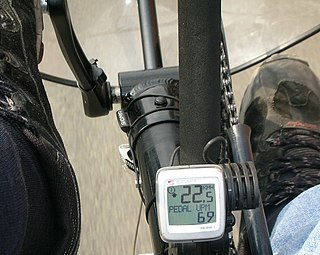 W
WIn cycling, cadence is the number of revolutions of the crank per minute; this is the rate at which a cyclist is pedalling/turning the pedals. Cadence is directly proportional to wheel speed, but is a distinct measurement and changes with gearing—which determines the ratio of crank rpm to wheel rpm.
 W
WIn the sport of cycling, a chain gang is a group of cyclists in a close knit formation usually of two parallel lines drafting behind the leader.
 W
WA climbing specialist or climber, also known as a grimpeur, is a road bicycle racer who can ride especially well on highly inclined roads, such as those found among hills or mountains.
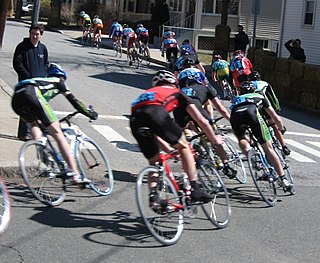 W
WA criterium, or crit, is a bike race consisting of several laps around a closed circuit, the length of each lap or circuit ranging from about 400 m to 10,000 m.
 W
WIn road bicycle racing, a domestique is a rider who works for the benefit of their team and leader, rather than trying to win the race. In French, domestique translates as "servant". The use of the term dates back to 1911, although such riders had existed before then.
 W
WDrafting or slipstreaming is an aerodynamic technique where two vehicles or other moving objects are caused to align in a close group, reducing the overall effect of drag due to exploiting the lead object's slipstream. Especially when high speeds are involved, as in motor racing and cycling, drafting can significantly reduce the paceline's average energy expenditure required to maintain a certain speed and can also slightly reduce the energy expenditure of the lead vehicle or object.
 W
WIn road bicycle racing the green jersey is a distinctive racing jersey worn by the most consistent highest finisher in the competition.
 W
WAn individual time trial (ITT) is a road bicycle race in which cyclists race alone against the clock. There are also track-based time trials where riders compete in velodromes, and team time trials (TTT). ITTs are also referred to as "the race of truth", as winning depends only on each rider's strength and endurance, and not on help provided by teammates and others riding ahead and creating a slipstream. Individual time trial are usually held on flat or rolling terrain, although sometimes they are held up a mountain road. Sometimes the opening stage of stage race is a very short individual time trial called a prologue.
 W
WIn a road bicycle race, the peloton is the main group or pack of riders. Riders in a group save energy by riding close to other riders. The reduction in drag is dramatic; riding in the middle of a well-developed group, drag can be reduced to as little as 5%-10%. Exploitation of this potential energy saving leads to very complex cooperative and competitive interactions between riders and teams in race tactics. The term is also used to refer to the community of professional cyclists in general, as in 'the professional peloton.'
 W
WThe mountains classification is a secondary competition in the Tour de France, that started in 1933. It is given to the rider that gains the most points for reaching mountain summits first. The leader of the classification is named the King of the Mountains, and since 1975 wears the polka dot jersey, a white jersey with red polka dots.
 W
WA puncheur or puncher is a road bicycle racer who specialises in rolling terrain with short but steep climbs.
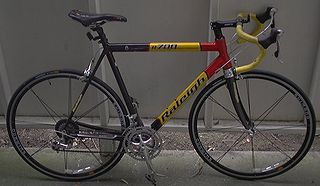 W
WA racing bicycle, also known as a road bike, and once popularly known as a ten speed, is a bicycle designed for competitive road cycling, a sport governed by and according to the rules of the Union Cycliste Internationale (UCI). The UCI rules were altered in 1934 to exclude recumbent bicycles.
 W
WThe rainbow jersey is the distinctive jersey worn by the reigning world champion in a cycling discipline, since 1927. The jersey is predominantly white with five horizontal bands in the UCI colours around the chest. From the bottom up the colours are: green, yellow, black, red and blue; the same colours that appear in the rings on the Olympic flag. The tradition is applied to all disciplines, including road racing, track racing, cyclo-cross, BMX, Trials and the disciplines within mountain biking. The jersey is produced by Santini SMS since 1994.
 W
WRepechage is a practice in series competitions that allows participants who failed to meet qualifying standards by a small margin to continue to the next round. A well known example is the wild card system.
 W
WThe Ruban Jaune (English; Yellow Ribbon) is a cycling title created in 1936 by Henri Desgrange, awarded to the rider recording the fastest average speed in a professional cycling race or stage longer than 200 km. The name is thought is to have come from comparison with the Blue Riband accolade awarded to the passenger liner crossing the Atlantic Ocean in record time. Desgrange changed the colour to yellow to reflect the newsprint of L'Auto, the sports newspaper he edited. The current holder of the Ruban Jaune is Philippe Gilbert.
 W
WA sprinter is a road bicycle racer or track racer who can finish a race very explosively by accelerating quickly to a high speed, often using the slipstream of another cyclist or group of cyclists tactically to conserve energy.
 W
WA cycling team is a group of cyclists who join a team or are acquired and train together to compete in bicycle races whether amateur or professional – and the supporting personnel. Cycling teams are most important in road bicycle racing, which is a team sport, but collaboration between team members is also important in track cycling and cyclo-cross.
 W
WA team time trial (TTT) is a road-based bicycle race in which teams of cyclists race against the clock.
 W
WA time trial bicycle is a racing bicycle designed for use in an individual race against the clock. Compared to a road bike, a time trial bike is more aerodynamic, has a shorter wheelbase, and puts the rider closer to the front of the bicycle. It may have either solid disc or spoked wheels.
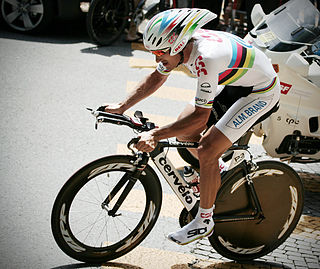 W
WA time trialist is a road bicycle racer who can maintain high speeds for long periods of time, to maximize performance during individual or team time trials. The term cronoman, or chronoman, is also used to refer to a time trialist.
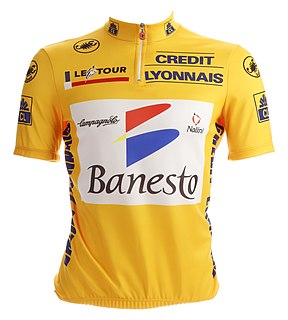 W
WThe general classification is the most important classification, the one by which the winner of the Tour de France is determined. Since 1919, the leader of the general classification wears the yellow jersey.